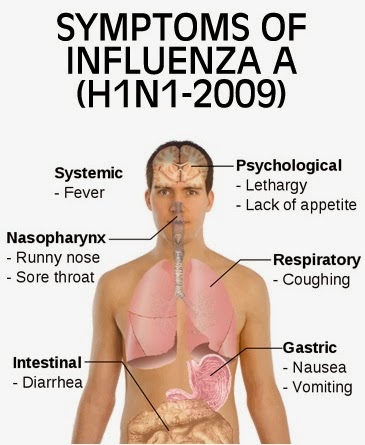If antiviral drugs are needed, then they should be given as early as possible. Starting antiviral drugs after 48 hours of onset of symptoms may not lead to discernible benefit, he further added.
In this regard, some Facts were also released by the IMA. These may help clinicians to select appropriate patients for antiviral drugs and/or hospitalization.
Facts
1. In the United States, 0.3% of all cases require admissions.
2. The mortality rate of flu pandemic is 0.12 deaths per 100,000 population.
3. Total number of deaths caused by pandemic H1N1 influenza A in the United States was lower than the number of deaths caused by seasonal influenza during non-pandemic years
4. Early and prompt initiation of antiviral therapy is recommended for children, adolescents, or adults with suspected or confirmed swine flu with any of the following features:
*Flu requiring hospitalization
*Progressive, severe, or complicated flu
*Severely immunosuppressed patients (receiving treatment for malignancies, hematopoietic or solid organ transplant recipients)
4. Swine flu at high risk for complications:
*Children <5 br="" particularly="" those="" years="">*Elderly =65 years
*Pregnant women
*Women up to 2 weeks postpartum
*Residents of nursing homes and other chronic care facilities
*Individuals with chronic medical conditions including: lung disease, including asthma (particularly if steroids have been required during the past year); heart disease, except isolated hypertension; active malignancy; chronic kidney disease, chronic liver disease, diabetes, sickle cell disease, other chronic disabling diseases and morbid obesity.
5. Severity of flu
Asymptomatic swine flu: Many contact illnesses may pass off without symptoms. In all 19 percent had serologically confirmed infection and 28 percent of those who were infected may remain asymptomatic.
Mild or uncomplicated swine flu (require no treatment, no hospitalization, no investigations)
*Fever, cough, sore throat, nasal discharge, muscle pain, headache, chills, malaise and sometimes diarrhea and vomiting
*No shortness of breath
*Little change in chronic health conditions.
Progressive illness. Requires hospitalization
*Above symptoms plus
*Chest pain
*Poor oxygenation (high respiratory rate, hypoxia, labored breathing in children)
*Low blood pressure
*Confusion, altered mental status
*Severe dehydration
*Exacerbations of asthma, chronic bronchitis, chronic renal failure, diabetes, or other cardiovascular conditions
Severe or complicated illness requires hospitalization
*Signs of lower respiratory tract disease
*Low oxygen requiring supplemental oxygen
*Pneumonia on x-ray
*Brain involvement
*BP lower than 80, organ failure
*Heart involvement
*Persistent high fever and other symptoms beyond 3 days
1. In the United States, 0.3% of all cases require admissions.
2. The mortality rate of flu pandemic is 0.12 deaths per 100,000 population.
3. Total number of deaths caused by pandemic H1N1 influenza A in the United States was lower than the number of deaths caused by seasonal influenza during non-pandemic years
4. Early and prompt initiation of antiviral therapy is recommended for children, adolescents, or adults with suspected or confirmed swine flu with any of the following features:
*Flu requiring hospitalization
*Progressive, severe, or complicated flu
*Severely immunosuppressed patients (receiving treatment for malignancies, hematopoietic or solid organ transplant recipients)
4. Swine flu at high risk for complications:
*Children <5 br="" particularly="" those="" years="">*Elderly =65 years
*Pregnant women
*Women up to 2 weeks postpartum
*Residents of nursing homes and other chronic care facilities
*Individuals with chronic medical conditions including: lung disease, including asthma (particularly if steroids have been required during the past year); heart disease, except isolated hypertension; active malignancy; chronic kidney disease, chronic liver disease, diabetes, sickle cell disease, other chronic disabling diseases and morbid obesity.
5. Severity of flu
Asymptomatic swine flu: Many contact illnesses may pass off without symptoms. In all 19 percent had serologically confirmed infection and 28 percent of those who were infected may remain asymptomatic.
Mild or uncomplicated swine flu (require no treatment, no hospitalization, no investigations)
*Fever, cough, sore throat, nasal discharge, muscle pain, headache, chills, malaise and sometimes diarrhea and vomiting
*No shortness of breath
*Little change in chronic health conditions.
Progressive illness. Requires hospitalization
*Above symptoms plus
*Chest pain
*Poor oxygenation (high respiratory rate, hypoxia, labored breathing in children)
*Low blood pressure
*Confusion, altered mental status
*Severe dehydration
*Exacerbations of asthma, chronic bronchitis, chronic renal failure, diabetes, or other cardiovascular conditions
Severe or complicated illness requires hospitalization
*Signs of lower respiratory tract disease
*Low oxygen requiring supplemental oxygen
*Pneumonia on x-ray
*Brain involvement
*BP lower than 80, organ failure
*Heart involvement
*Persistent high fever and other symptoms beyond 3 days
